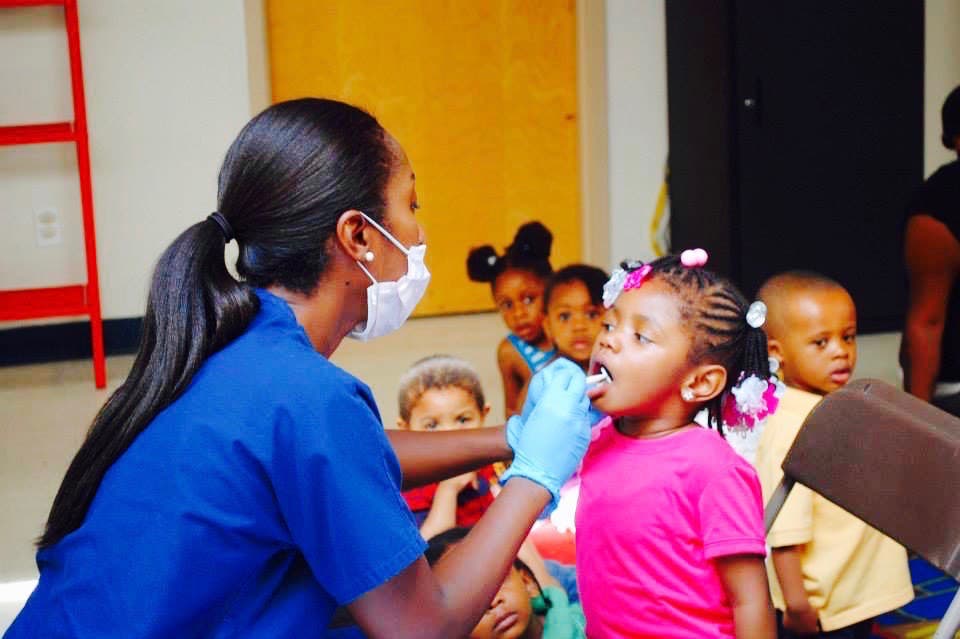School dental program prevents 80% of cavities in a single, non-invasive treatment
A single dose given in elementary schools prevented roughly 80% of cavities and kept 50% of cavities from worsening even 2 years later.

[Feb. 12, 2023: Rachel Harrison, New York University]
The robotic microswarm could be particularly valuable for those who lack the manual dexterity to clean their teeth effectively themselves.. (CREDIT: Creative Commons)
In a study of nearly 3,000 schoolchildren, silver diamine fluoride—a liquid that is brushed onto the surface of teeth to prevent cavities or keep them from worsening—was as effective against cavities as dental sealants, the standard of care. A single dose of either topical treatment given in elementary schools prevented roughly 80% of cavities and kept 50% of cavities from worsening when children were seen two years later.
The findings, published in JAMA Network Open, offer an efficient and cost-effective approach to improving children’s oral health through school-based care.
Dental cavities are the most common chronic disease in children, and kids from low-income families are twice as likely to have cavities as those from higher-income families. Without proper and timely intervention, cavities can lead to severe infections, reduce children’s quality of life, and are associated with lower student academic performance and school attendance. But getting kids to a dentist for the recommended twice-yearly visits can be challenging, especially when parents need to take time off of work.
To reduce the barriers to seeing a dentist, some basic dental services can be offered in schools, especially those serving children from low-income families. For example, the Centers for Disease Control and Prevention recommends and funds school sealant programs. In 2017, NYU College of Dentistry researchers received funding from the Patient-Centered Outcomes Research Institute (PCORI) to run the nation’s largest school-based cavity prevention study, which they named CariedAway.
Related Stories
CariedAway is a randomized trial comparing the effectiveness of two cavity-prevention techniques: a “simple” treatment using silver diamine fluoride (SDF) and fluoride varnish, and a “complex” treatment using traditional glass ionomer sealants and fluoride varnish. Both are non-invasive and applied to the surface of teeth to prevent and arrest cavities in children, but for the same time and cost, providers can treat more children with the simpler SDF therapy.
The study included 2,998 children in kindergarten through third grade at 47 New York City schools. The schools—which serve a racially diverse group of students, most of whom are from low-income families—were randomized to receive either the simple or complex treatment.
Upon visiting each school, the clinical research team—which included a supervising dentist, dental hygienists, registered nurses, and assistants—did baseline exams to measure any tooth decay, and then applied fluoride varnish and either sealants or SDF, depending on whether the school was assigned to receive the complex or simple treatment.
A cavity prevention program in Bronx elementary schools was found to prevent 80% of cavities. (CREDIT: NYU Photo Bureau)
The initial visits took place in 2019 and early 2020, and were paused when the COVID-19 pandemic temporarily closed New York City schools and halted all school-based care. Two years later, schools allowed the clinical research team to resume, and they returned to each school for follow-up visits.
The researchers found that both the simple and complex treatments were successful: just one cavity prevention treatment prevented more than 80% of cavities (81% for SDF and 82% for sealants) and stopped half of cavities from progressing (56% for SDF and 46% for sealants).
Visual Abstract. Effect of Silver Diamine Fluoride on Caries Arrest and Prevention. (CREDIT: JAMA Network)
“Without prevention, dental cavities grow continuously if not treated. One CariedAway cavity prevention treatment, provided just before schools closed during the pandemic, was remarkably effective over the following two-year period,” said Richard Niederman, DMD, professor in the Department of Epidemiology & Health Promotion at NYU College of Dentistry, co-principal investigator of CariedAway, and the study’s senior author. “I know of no other dental preventive intervention that had this great a beneficial impact across the pandemic.”
While the limited availability of trained dental professionals can pose challenges for school sealant programs, as sealants are applied by a dentist or dental hygienist, SDF may be an attractive alternative, as it can also be applied by nurses—a workforce already in place in many schools.
“Our results support the use of SDF for cavity prevention in school-based oral health programs and offer an opportunity for expanding access to critical oral health care,” said Ryan Richard Ruff, MPH, PhD, associate professor in the Department of Epidemiology & Health Promotion at NYU College of Dentistry, co-principal investigator of CariedAway and the study’s first author.
Note: Materials provided above by New York University. Content may be edited for style and length.
Like these kind of feel good stories? Get the Brighter Side of News' newsletter.
Joseph Shavit
Head Science News Writer | Communicating Innovation & Discovery
Based in Los Angeles, Joseph Shavit is an accomplished science journalist, head science news writer and co-founder at The Brighter Side of News, where he translates cutting-edge discoveries into compelling stories for a broad audience. With a strong background spanning science, business, product management, media leadership, and entrepreneurship, Joseph brings a unique perspective to science communication. His expertise allows him to uncover the intersection of technological advancements and market potential, shedding light on how groundbreaking research evolves into transformative products and industries.



